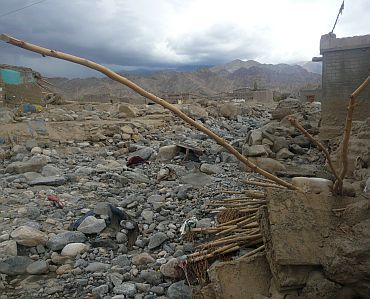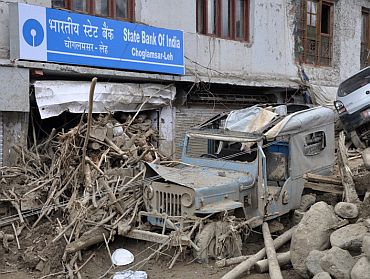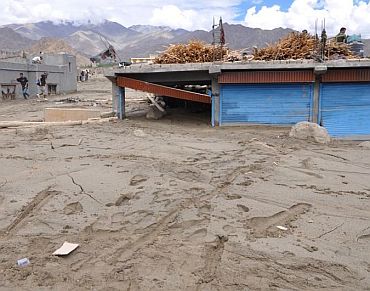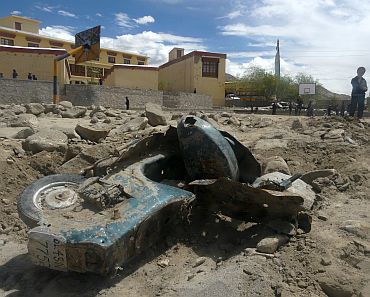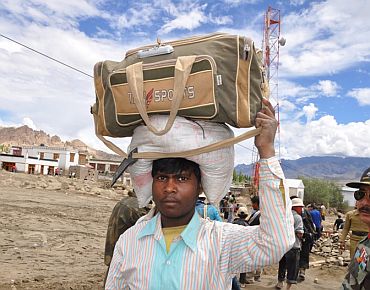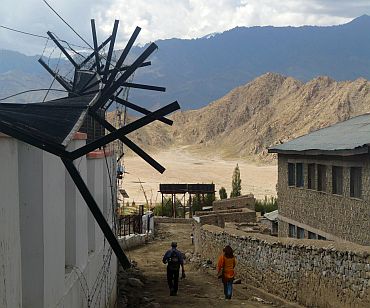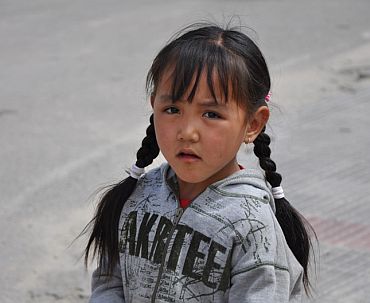 | « Back to article | Print this article |
There's no one in Choglamsar. It's a ghost town
Last updated on: September 9, 2010 10:46 IST
Dilip D'Souza has witnessed disasters around the world. However, the sight of devasatation in Leh left him speechless and overwhelmed.Nothing in my experience prepares me for the destruction a flood caused in Ladakh.
Thing is, it is not that the scenes there were unlike anything I had seen before. I have been in Orissa after the 1999 'super-cyclone', in Kutch after the 2001 quake, in Tamil Nadu after the 2004 tsunami, and in New Orleans after 2005 Katrina.
The destruction in all those places was certainly similar to what I saw in Ladakh, in fact on an even larger scale.
Yet here's the point, again: Nothing prepares me for the destruction. Not even previous destruction. This time like every time, it hits me like an express train in the gut.
In Choglamsar, 5 km east of Leh, I stand open-mouthed. From where I do so, from below my feet, an unbroken river of boulders stretches all the way to the distant hills to the north -- like a dry riverbed, like plenty such that I have seen.
There were only rocks
Last updated on: September 9, 2010 10:46 IST
This is one that I would have paid little attention to otherwise, apart from some of the boulders, Maruti 800 sized that they are. But today there are two things I have to coax my mind to comprehend here, and neither comes easy.
One, on the night of August 5, the water brought these boulders. I cannot imagine the power in water that would roll these Maruti scale rocks along.
Two, where this dry riverbed slices through Choglamsar today, there used to be houses. Until about midnight that night of August 5, there used to be houses. About fifteen minutes later, there were no houses.
There were only rocks.
Water slammed into Choglamsar like an express train
Last updated on: September 9, 2010 10:46 IST
Because up in those distant hills that night, above the hamlet of Saboo, a cloud burst and dumped some unthinkable, unmeasurable amount of water on the ground below.With nowhere to go but downhill, the water hurtled that way, picking up mud and boulders and whatever else could not resist its immense force, smashing anything manmade and killing 14 people in Saboo.
Then it slammed into Choglamsar like an express train a million times more destructive than the one I feel in my gut as I stand here. Open-mouthed.
Maybe a billion times more destructive, I don't know.
'Are you sure there were houses here?'
Last updated on: September 9, 2010 10:46 IST
On either side of me, there are severely damaged houses, mud-filled houses, clearly unlivable houses. Many. But right where I stand, there's not even a sign of houses. I am so hard-pressed to believe that there were homes here, people living here, that I turn to Tsering Sandrup for persuasion.A young soldier on leave, Tsering has come to help his brother dig the mud out of his home. It stands on the edge of the rocks, half-submerged in mud, badly damaged.
The brother is inside with a shovel, flinging mud out through the front door whose top is now at waist level: that's how much mud engulfed the area.
"Are you sure," I ask Tsering, "that there were houses here?"
It's not the first time I've asked him this. He gives me a look that says, "How much will it take for this guy to be convinced?" He takes me by the elbow and leads me to one corner of his brother's house.
'There were houses and more houses. All gone!'
Last updated on: September 9, 2010 10:46 IST
Points down, and I see a small patch of what used to be a verandah, pale green with forlorn swirls in the broken tiles. "You see that?" he asks."This verandah used to extend to about " and he steps about fifteen feet away into the rocks, " here. Now you can see there is nothing."
Nothing, that is, except for this small patch.
So what he is saying is that the water tore away nearly the entire verandah. "Beyond the verandah," says Tsering, pointing across the rocks, "there were houses and more houses. All gone."
I believe him. Though it is still hard.
I could be standing on many sudden graves
Last updated on: September 9, 2010 10:46 IST
In those fifteen minutes that night, something like a hundred people died in Choglamsar, obliterated with their homes.That, I hear, is the known, or official toll. Plenty of people say to me, "Who knows how many are still under the mud and stones?"
It is true. I could easily be standing on a number of sudden graves.
Though it does strike me that these days later, especially in a place like this that was filled with families and neighbours, it's likely someone can make a good estimate of the number of people still missing, if any, with their names.
Survivors would probably know who is left to be accounted for.
Choglamsar is a ghost town
Last updated on: September 9, 2010 10:46 IST
Contrast that with the tales of migrant labourers from Bihar and Jharkhand who were washed away by the flood.An army officer tells me about one such group that was camped on the Srinagar highway, not far from his own regimental centre.
The swollen Indus, he says, swallowed them without a trace. Nobody has any idea of their numbers or names.
If this is true, the real death toll in Ladakh -- if it can ever be accurately determined, if all the bodies are ever found -- will be substantially higher than the estimates so far, close to 200.
Here in Choglamsar for now, I am conscious of the dead, but for now I am thinking more about the living. I'm thinking of the people who fled this place that night, turning Choglamsar into a ghost town that looks like a war zone. I mean, there's nobody left here.
Not a soul.
Where will they go when winter arrives?
Last updated on: September 9, 2010 10:46 IST
Just stones and damaged shells of houses, with the occasional wreck of a car or scooter; just a few dispirited dogs picking over the debris.Many Choglamsar residents are in tents in two nearby camps. They are okay for now, if still stunned by what happened to them.
But what happens in less than two months, when Ladakh's notoriously severe winter sets in? Where will they go?
There's talk of building homes for them, but when I meet them over two weeks after the flood, no such effort has got off the ground.
In any case, who will build the homes? Using what design principles? What materials?
'I cannot get them out of my mind'
Last updated on: September 9, 2010 10:46 IST
Government or even well meaning NGOs have too often built uninhabitable concrete blocks to house affected people in other disaster areas.Will the same happen here? Really, what will happen to these people when winter comes?
Perhaps those questions need longer than two weeks to answer.
Yet they cry out for answers.
Here in Choglamsar, I cannot get them out of my mind. Like I cannot get obliterated houses out of my mind.
